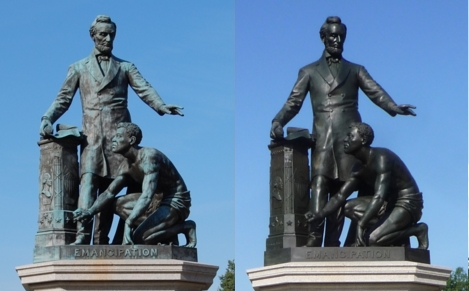 While I was escaping the heat of DC this summer, a great change came over Lincoln Park: The Emancipation Statue there was cleaned up and about 100 years of copper carbonate was removed from it, changing it from a statue with a greenish cast to a deep brown. I didn’t watch the transformation, but was intrigued by it, so I contacted Nation Capital Parks-East, who were kind enough to answer all my questions about the cleaning job.
While I was escaping the heat of DC this summer, a great change came over Lincoln Park: The Emancipation Statue there was cleaned up and about 100 years of copper carbonate was removed from it, changing it from a statue with a greenish cast to a deep brown. I didn’t watch the transformation, but was intrigued by it, so I contacted Nation Capital Parks-East, who were kind enough to answer all my questions about the cleaning job.
Pictures from the early days of the Emancipation Statue show both figures to be evenly colored, and of a dark cast – what shade exactly is impossible to tell on the old black and white images. Even pictures from the early days of the 20th Century show the statue basically unchanged. In recent years, however, the statue has been covered in a greenish cast, which indicates that environmental oxygen and carbon have formed copper carbonate (CuCO3). The National Capital Parks-East, who are responsible for the park and its statues, determined that it was time for a proper cleaning, and bringing Thomas Ball‘s statue back to the color it had when erected.
Cleaning a statue such as this is a long, multistage process, it turns out. The work was done over eight days by two National Parks workers, James Allen and Jerome Butler. The first step was a simple cleaning with water and detergent. This included pressure washing the statue to remove all the scale and dirt.
Following this treatment, and after thoroughly drying it, the statue was painted with Bensotriazole (BTA). BTA works by reacting with the copper, forming two bonds with each copper atom, and ensuring that the copper will not bond with environmental oxygen and carbon to reform the green patina that we know of on the statue.
The next step was to wax the statue. Allen began by heating the statue to the point beeswax would melt on it (which was presumably did not require much during the August heat) and then painted wax mixed with mineral spirits on it. This layer of wax was then buffed with cotton rags and lamb wool mitts. A final layer of wax was added and once again, buffed using the rags and mitts, leaving the statue with the deep glossy patina that you can see today.
A similar job was done on the Mary MacLeod Bethune statue on the other side of the park, though here the oxidation of the statue had not yet set in so thoroughly, so the difference was not as stark. Allen, who has been doing work of this nature for 20 years, and has polished up numerous statues around DC, says that beeswax treatment should last at least two years, and thus will be repeated in about 2013.
In the meantime, enjoy seeing the Emancipation Group as it was originally meant to be.
I would like to thank Douglas Carr, Chief of Grounds, and Alex Romero, Superintendent, of National Capital Parks-East for their help in answering my questions.

